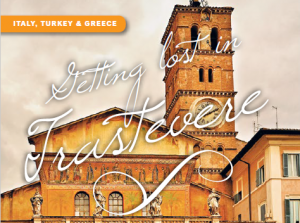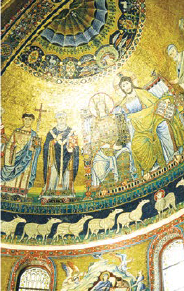 “Watching the students interact with the locals in the Trastevere district was glorious. They were using the language appropriately and navigating around the locals and the street vendors with ease, really embracing everything they’d learned. It changed them.”
“Watching the students interact with the locals in the Trastevere district was glorious. They were using the language appropriately and navigating around the locals and the street vendors with ease, really embracing everything they’d learned. It changed them.”
–Morgan, art teacher, Insider’s Italy 2015
Sun-soaked from a long day of sightseeing, you find yourself walking down a winding, cobblestone alleyway lined with ivy-clad walls. Elderly men play chess in the streets, verbally sparring in Italian between checks and checkmates. A street musician warms up his accordion as university students gather around the fountain steps. Terra Cotta buildings cast a sunset glow, and the street lamps are just starting to flicker. You feel the sudden urge to sit and stay awhile. Welcome to Trastevere.
 Your students might marvel over the stalwart but simultaneously intricate structure of the Pantheon, or spend hours craning their necks to gaze at Michelangelo’s Sistine masterpiece. The view from inside the Colosseum might elicit oohs and aahs. But aside from the relics and ancient architecture dotted along its paved streets, Rome is a world-class city moving at a breakneck pace, more akin to a modern metropolis like New York or Shanghai than the rest of “the old country.” Yet even within the big, bustling city, you can take your students back in time, to a place where the pace is relaxed and it feels just a little bit like home…no matter where you’re from.
Your students might marvel over the stalwart but simultaneously intricate structure of the Pantheon, or spend hours craning their necks to gaze at Michelangelo’s Sistine masterpiece. The view from inside the Colosseum might elicit oohs and aahs. But aside from the relics and ancient architecture dotted along its paved streets, Rome is a world-class city moving at a breakneck pace, more akin to a modern metropolis like New York or Shanghai than the rest of “the old country.” Yet even within the big, bustling city, you can take your students back in time, to a place where the pace is relaxed and it feels just a little bit like home…no matter where you’re from.
Cue Trastevere, a quaint neighborhood on the west bank of the Tiber, characterized by cobblestone alleyways, hanging vines, and al fresco dining. One of the few remnants of medieval Rome and a part of the city’s centro storico (historical center), Trastevere has developed its own distinct flavor throughout the centuries. Filled with old world charm, Trastevere can give your students a culturally immersive experience and a break from the big city within the city, with charming cafes, gelaterias, and lesser-known historical sites in a dreamlike, old Italian setting. Because of this isolation and the neighborhood’s multicultural population since the ancient Roman period, the inhabitants of Trastevere, called Trasteverini, developed a culture of their own.
Want to experience the culture of Italy? Take a look at the Rome, Città Eterna tour.
